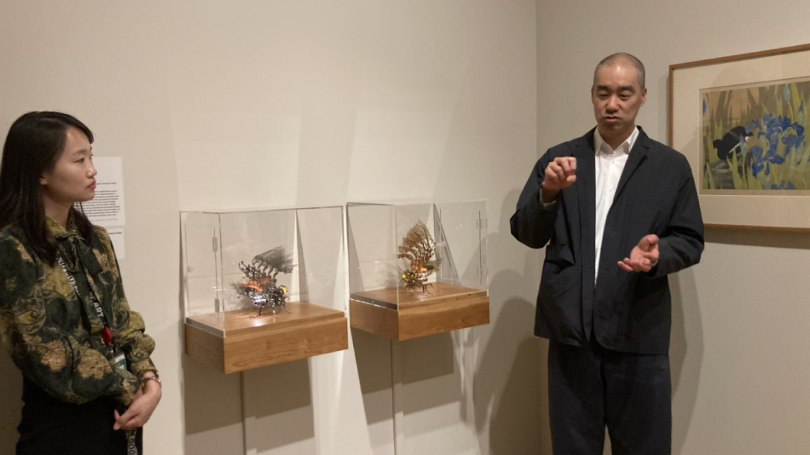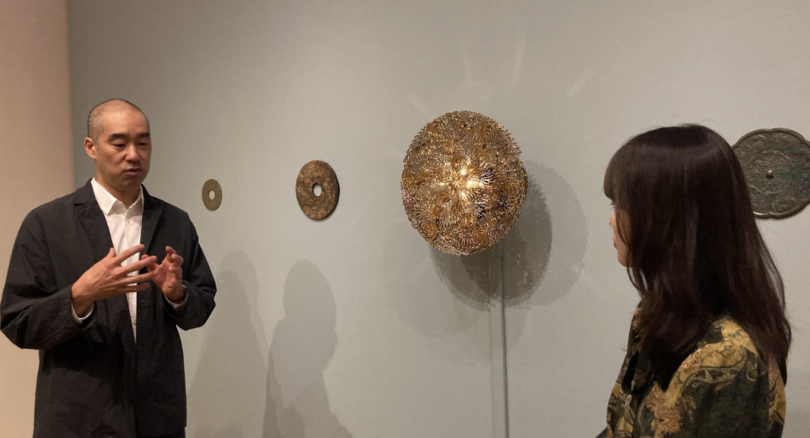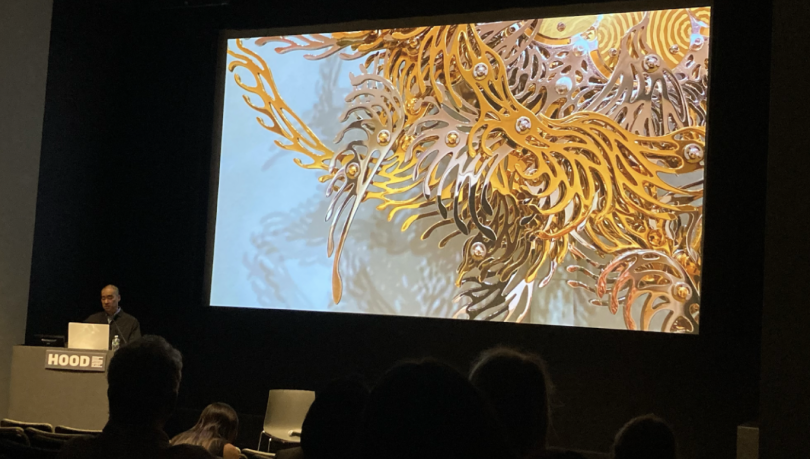
Hood Museum: Choe U-Ram
One of the many perks of having a museum on campus is the opportunity to interact with a wide breadth of art pieces. In addition to displaying a variety of curated exhibits, the Hood Museum occasionally hosts artists who speak about their creative process, their journey as an artist, and other topics in a free-form Q&A session.
Recently, I had the honor of hearing from Choe U-Ram, a Korean kinetic artist who currently has three of his pieces on display in the Hood. Choe's Gold Cakra Lamp (2013), Gold Insecta Lamp (2013), and Silver Insecta Lamp (2013), are a part of the exhibit Attitudes of Coexistence: Non-Humans in East Asian Art, which was curated by Haely Chang, the Hood Museum's inaugural Jane and Raphael Bernstein Associate Curator of East Asian Art. The museum offered two opportunities to hear from Choe: an intimate talk about the three pieces on display and a public "artist talk" the next day.

The first work Choe U-Ram and Chang discussed was the two insecta lamps, one in gold and one in silver. With one touch of the insect's tail, the lamp glows a warm orange hue. With a second touch, the insecta lamps come to life, their lacy wings cycling in mesmerizing patterns.
Choe explains that these insecta lamps were created during a period when he was struggling to sell his work. Choe's sculptures often require large exhibition galleries to accommodate their sheer size, so the insecta lamps were designed to be small in hopes that someone would buy them as home decor. Their form draws upon his Anima Machine series, which imagines organisms from a cybernetic future. Choe notes that technology was created to make human dreams come true, but what happens when the technology grows a mind of its own? In our discussion, Choe mused that in the age of AI, his Anima Machine curiosities may actually become a reality.

Next, we were prompted to continue down the exhibit and walk slowly towards the Gold Cakra Lamp (2013), which unfolded and pulsed—almost like a heartbeat, in reaction to our entrance. Choe explains that the lamp was created after he began meditating and studying Buddhist texts. The lamp is his rendition of a harmonious society, represented through the unified movement of the lamp's wings. The wings open and close, sliding in between each other and revealing or obscuring a light housed in the lamp's center. Choe notes that the lamp repeats its movements for eight cycles, for the eight teachings of the Noble Eightfold Path.
Chang made an interesting point about the different questions student groups have asked her about Choe's pieces. In particular, engineering students often ask technical questions, such as "Where are the motors?" and "How was this motion designed?" While art students tend to ask about the meaning behind the works or how Choe created the intricate wing details. In addition, the Cakra Lamp incorporates an extra philosophical layer into Choe's process. Choe's interdisciplinary sculptures intersect art, engineering, and philosophy, forming these unique kinetic pieces.
There was also an interesting question posed to Chang, the curator of the exhibit, about the process of curation and the considerations that went into displaying the art. Chang explained that while Choe's lamps are best viewed in dimmer conditions, due to accessibility concerns, the exhibit's current display was as dim as possible. In addition, Chang and the museum curation team explored a variety of accompaniments for the lamp, including various arrangements of the metal discs in the final display. They decided on a linear arrangement as "the room fell silent and it just clicked". As someone who has attended many museums before, I've never thought about the process and care behind art curation. The Hood Museum offers a place for those conversations on campus, which I likely would not have engaged with otherwise.

The next day, I also attended Choe's "artist talk," where he detailed his creative process from his upbringing through to the present day. As a child, Choe's creativity was encouraged by his parents, both of whom are artists. But Choe was most interested in engineering, particularly building robots. However, due to poor math grades, Choe gave up on becoming an engineer and went to art school to study sculpture. Along the way, Choe realized that he could merge his interests in mechanics and sculpture, leading to the idea of kinetic sculptures.
Choe's story highlights the importance of a liberal arts education. It was only because Choe was exposed to a variety of subjects that he was able to hone in on kinetic sculptures. Hearing how he faced challenges throughout his creative process, such as in his early days, when he brought his pieces home from the galleries for repairs every night, was very inspiring. As I'm preparing to declare my major, I hope to use some of Choe's ingenuity to spin a course of study that encompasses all my interests.
Although I wasn't very familiar with Choe's work previously, I'm glad I took the chance to listen in on his talks. Learning about the theory behind his work, his creative process, and his journey as an artist was an inspiring listen. Who knows, maybe you'll meet your next favorite artist at a Hood Museum artist talk!















